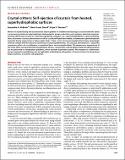Crystal critters: Self-ejection of crystals from heated, superhydrophobic surfaces
Author(s)
McBride, Samantha A.; Girard, Henri-Louis; Varanasi, Kripa K.
DownloadPublished version (2.768Mb)
Publisher with Creative Commons License
Publisher with Creative Commons License
Creative Commons Attribution
Terms of use
Metadata
Show full item recordAbstract
Mineral or crystal fouling (the accumulation of precipitants on a material and damage associated with the same) is a pervasive problem in water treatment, thermoelectric power production, and numerous industrial processes. Growing efforts have focused on materials engineering strategies (e.g., superhydrophobicity) to prevent fouling. Here, we present a curious phenomenon in which crystals self-eject from heated, nanotextured superhydrophobic materials during evaporation of saline water drops. These crystal structures (crystal critters) have exceedingly minimal contact with the substrate and thus pre-empt crystal fouling. This unusual phenomenon is caused by cooperative effects of crystallization, evaporative flows, and nanoscale effects. The temperature dependence of the critter effect can be predicted using principles of mass conservation, and we demonstrate that self-propulsion can be generated via temperature gradients, which promote asymmetric growth. The insights on confinement- driven evaporative crystallization can be applied for antifouling by self-ejection of mineral foulants, for drop-based fluidic machines, or even for self-propulsion
Date issued
2021-04Department
Massachusetts Institute of Technology. Department of Mechanical EngineeringJournal
Science Advances
Publisher
American Association for the Advancement of Science (AAAS)
Citation
McBride, Samantha A, Girard, Henri-Louis and Varanasi, Kripa K. 2021. "Crystal critters: Self-ejection of crystals from heated, superhydrophobic surfaces." Science Advances, 7 (18).
Version: Final published version
ISSN
2375-2548